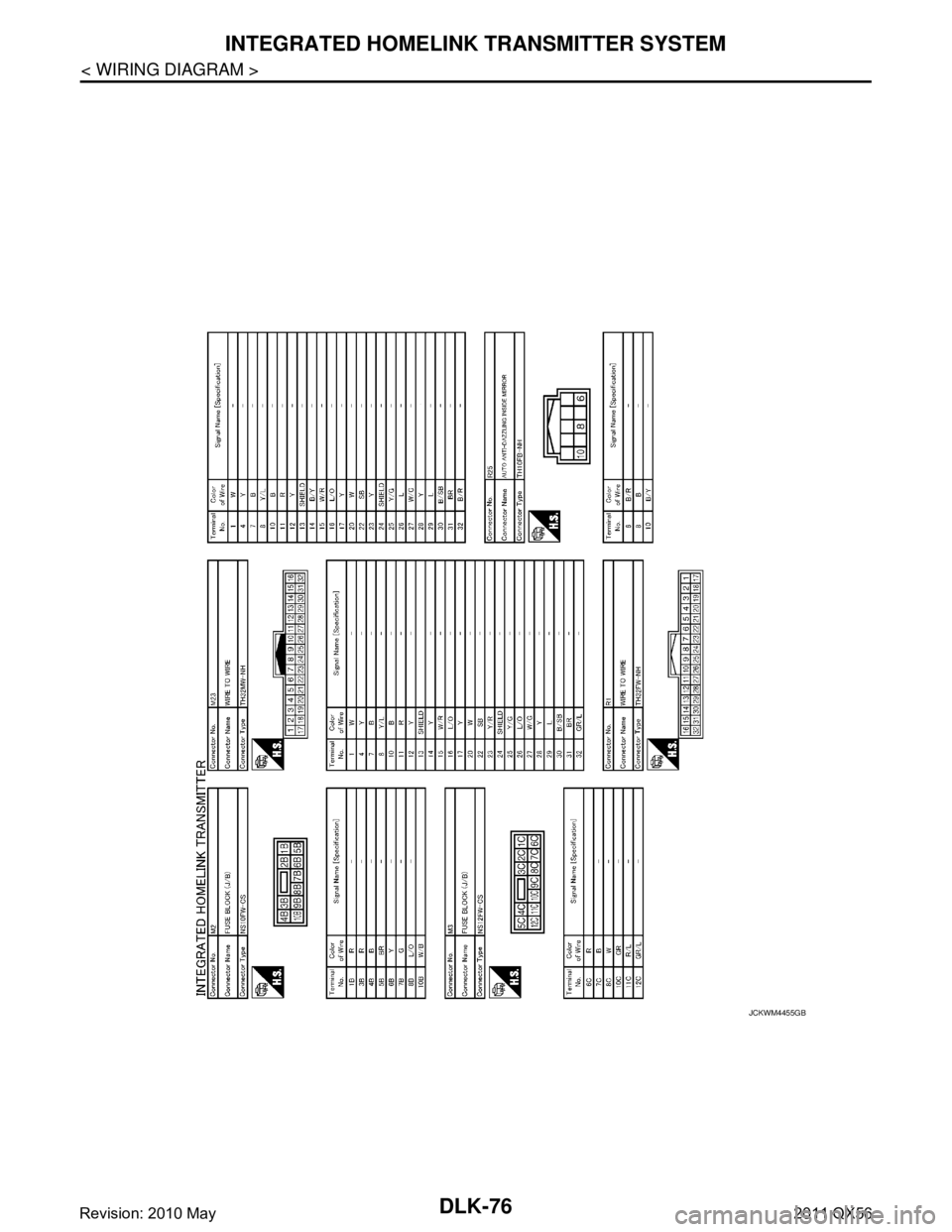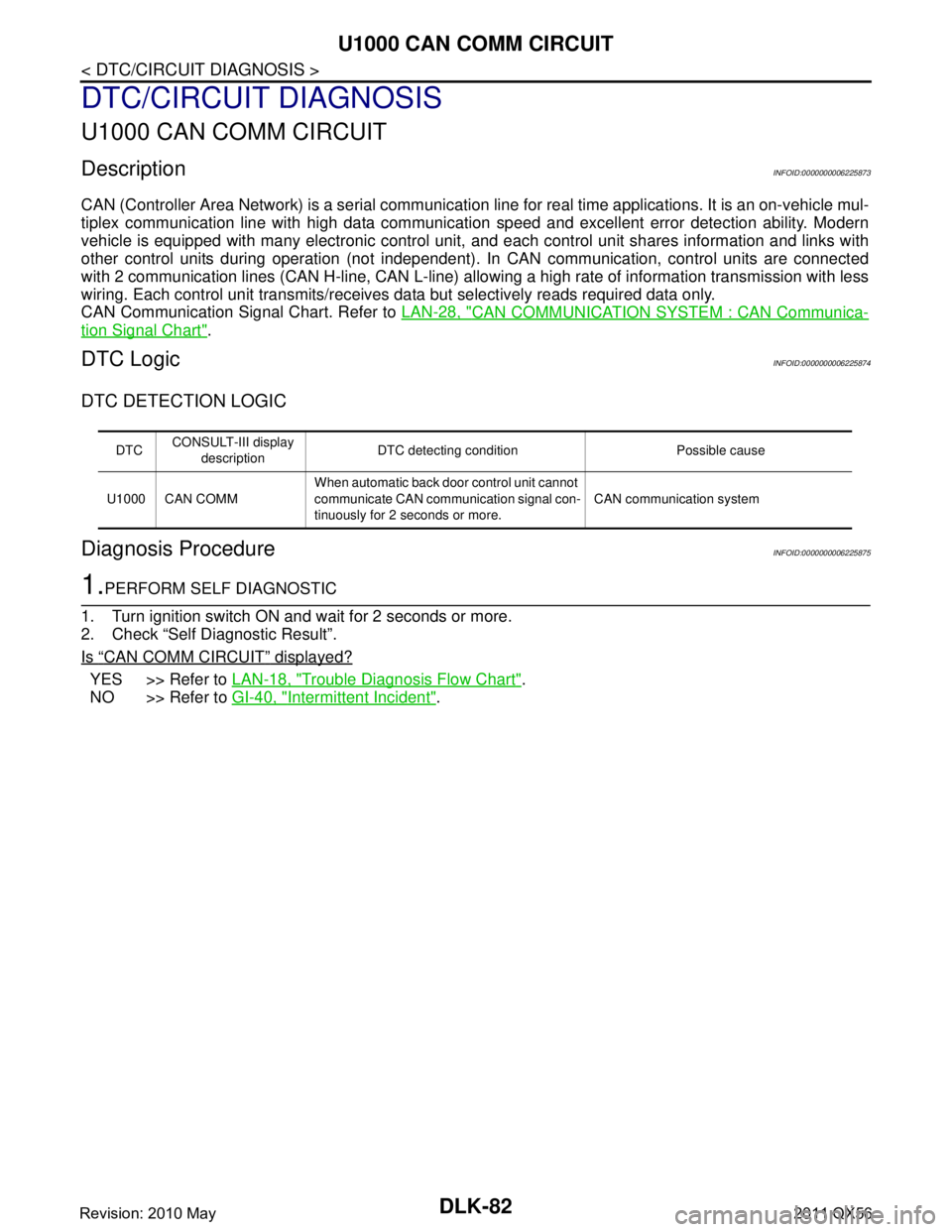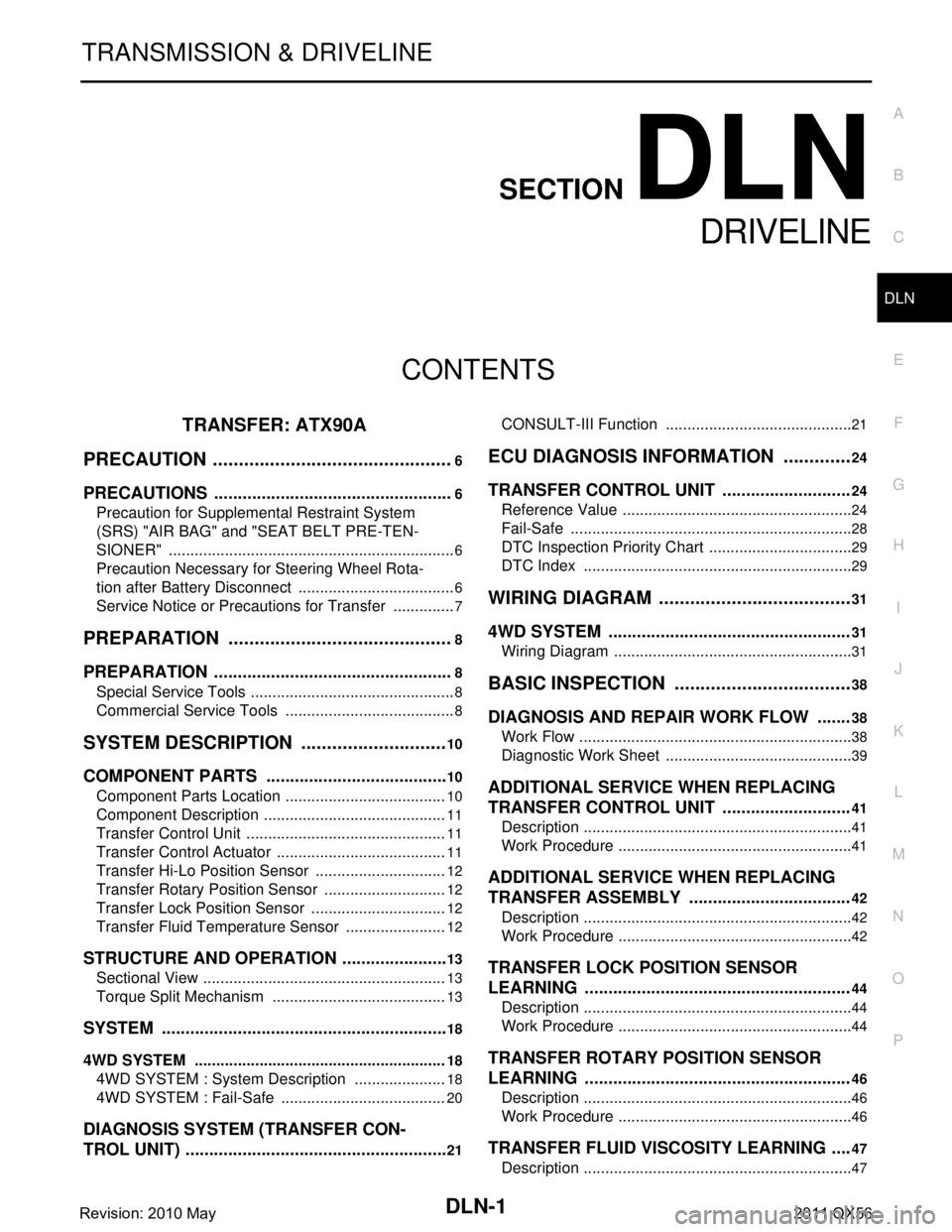2011 INFINITI QX56 wiring
[x] Cancel search: wiringPage 1612 of 5598

DLK-76
< WIRING DIAGRAM >
INTEGRATED HOMELINK TRANSMITTER SYSTEM
JCKWM4455GB
Revision: 2010 May2011 QX56
Page 1618 of 5598

DLK-82
< DTC/CIRCUIT DIAGNOSIS >
U1000 CAN COMM CIRCUIT
DTC/CIRCUIT DIAGNOSIS
U1000 CAN COMM CIRCUIT
DescriptionINFOID:0000000006225873
CAN (Controller Area Network) is a serial communication line for real time applications. It is an on-vehicle mul-
tiplex communication line with high data communication speed and excellent error detection ability. Modern
vehicle is equipped with many electronic control unit, and each control unit shares information and links with
other control units during operation (not independent). In CAN communication, control units are connected
with 2 communication lines (CAN H-line, CAN L-line) al lowing a high rate of information transmission with less
wiring. Each control unit transmits/receives data but selectively reads required data only.
CAN Communication Signal Chart. Refer to LAN-28, "
CAN COMMUNICATION SYSTEM : CAN Communica-
tion Signal Chart".
DTC LogicINFOID:0000000006225874
DTC DETECTION LOGIC
Diagnosis ProcedureINFOID:0000000006225875
1.PERFORM SELF DIAGNOSTIC
1. Turn ignition switch ON and wait for 2 seconds or more.
2. Check “Self Diagnostic Result”.
Is
“CAN COMM CIRCUIT” displayed?
YES >> Refer to LAN-18, "Trouble Diagnosis Flow Chart".
NO >> Refer to GI-40, "
Intermittent Incident".
DTCCONSULT-III display
description DTC detecting condition Possible cause
U1000 CAN COMM When automatic back door control unit cannot
communicate CAN communication signal con-
tinuously for 2 seconds or more.
CAN communication system
Revision: 2010 May2011 QX56
Page 1747 of 5598

SQUEAK AND RATTLE TROUBLE DIAGNOSESDLK-211
< SYMPTOM DIAGNOSIS >
C
DE
F
G H
I
J
L
M A
B
DLK
N
O P
Insulates where slight movement is present. Ideal for instrument panel applications.
SILICONE GREASE
Used in place of UHMW tape that is be visible or does not fit. Will only last a few months.
SILICONE SPRAY
Used when grease cannot be applied.
DUCT TAPE
Used to eliminate movement.
CONFIRM THE REPAIR
Confirm that the cause of a noise is repaired by test driving the vehicle. Operate the vehicle under the same
conditions as when the noise originally occurred. Refer to the notes on the Diagnostic Worksheet.
Inspection ProcedureINFOID:0000000006226060
Refer to Table of Contents for specific component removal and installation information.
INSTRUMENT PANEL
Most incidents are caused by contact and movement between:
1. Cluster lid A and instrument panel
2. Acrylic lens and combination meter housing
3. Instrument panel to front pillar garnish
4. Instrument panel to windshield
5. Instrument panel mounting pins
6. Wiring harnesses behind the combination meter
7. A/C defroster duct and duct joint
These incidents can usually be located by tapping or moving the components to duplicate the noise or by
pressing on the components while driving to stop the noi se. Most of these incidents can be repaired by apply-
ing felt cloth tape or silicon spray (in hard to reach areas). Urethane pads can be used to insulate wiring har-
ness.
CAUTION:
Do not use silicone spray to isolate a squeak or ra ttle. If you saturate the area with silicone, you will
not be able to recheck the repair.
CENTER CONSOLE
Components to pay attention to include:
1. Shifter assembly cover to finisher
2. A/C control unit and cluster lid C
3. Wiring harnesses behind audio and A/C control unit
The instrument panel repair and isolation pr ocedures also apply to the center console.
DOORS
Pay attention to the:
1. Finisher and inner panel making a slapping noise
2. Inside handle escutcheon to door finisher
3. Wiring harnesses tapping
4. Door striker out of alignment causing a popping noise on starts and stops
Tapping or moving the components or pressing on them while driving to duplicate the conditions can isolate
many of these incidents. You can usually insulate the areas with felt cloth tape or insulator foam blocks to
repair the noise.
TRUNK
Trunk noises are often caused by a loose jack or loose items put into the trunk by the owner.
In addition look for:
1. Trunk lid dumpers out of adjustment
2. Trunk lid striker out of adjustment
3. Trunk lid torsion bars knocking together
4. A loose license plate or bracket
Revision: 2010 May2011 QX56
Page 1803 of 5598

DLN-1
TRANSMISSION & DRIVELINE
CEF
G H
I
J
K L
M
SECTION DLN
A
B
DLN
N
O P
CONTENTS
DRIVELINE
TRANSFER: ATX90A
PRECAUTION ................ ...............................
6
PRECAUTIONS .............................................. .....6
Precaution for Supplemental Restraint System
(SRS) "AIR BAG" and "SEAT BELT PRE-TEN-
SIONER" ............................................................. ......
6
Precaution Necessary for Steering Wheel Rota-
tion after Battery Disconnect .....................................
6
Service Notice or Precautions for Transfer ...............7
PREPARATION ............................................8
PREPARATION .............................................. .....8
Special Service Tools .......................................... ......8
Commercial Service Tools ........................................8
SYSTEM DESCRIPTION .............................10
COMPONENT PARTS ................................... ....10
Component Parts Location .................................. ....10
Component Description ...........................................11
Transfer Control Unit ...............................................11
Transfer Control Actuator ........................................11
Transfer Hi-Lo Position Sensor ...............................12
Transfer Rotary Position Sensor .............................12
Transfer Lock Position Sensor ................................12
Transfer Fluid Temperature Sensor ........................12
STRUCTURE AND OPERATION .......................13
Sectional View ..................................................... ....13
Torque Split Mechanism .........................................13
SYSTEM .............................................................18
4WD SYSTEM ...........................................................18
4WD SYSTEM : System De scription ......................18
4WD SYSTEM : Fail-Safe ......................... ..............20
DIAGNOSIS SYSTEM (TRANSFER CON-
TROL UNIT) .................................................... ....
21
CONSULT-III Function ........................................ ....21
ECU DIAGNOSIS INFORMATION ..............24
TRANSFER CONTROL UNIT ...........................24
Reference Value .................................................. ....24
Fail-Safe ..................................................................28
DTC Inspection Priority Chart ..................................29
DTC Index ...............................................................29
WIRING DIAGRAM ......................................31
4WD SYSTEM .. ................................ .................31
Wiring Diagram .................................................... ....31
BASIC INSPECTION ...................................38
DIAGNOSIS AND REPAIR WORK FLOW .......38
Work Flow ............................................................ ....38
Diagnostic Work Sheet ............................................39
ADDITIONAL SERVICE WHEN REPLACING
TRANSFER CONTROL UNIT ...........................
41
Description ...............................................................41
Work Procedure .......................................................41
ADDITIONAL SERVICE WHEN REPLACING
TRANSFER ASSEMBLY ..................................
42
Description ...............................................................42
Work Procedure .......................................................42
TRANSFER LOCK POSITION SENSOR
LEARNING ....................................... .................
44
Description ........................................................... ....44
Work Procedure .......................................................44
TRANSFER ROTARY POSITION SENSOR
LEARNING ....................................... .................
46
Description ........................................................... ....46
Work Procedure .......................................................46
TRANSFER FLUID VISCOSITY LEARNING ....47
Description ...............................................................47
Revision: 2010 May2011 QX56
Page 1808 of 5598
![INFINITI QX56 2011 Factory Service Manual
DLN-6
< PRECAUTION >[TRANSFER: ATX90A]
PRECAUTIONS
PRECAUTION
PRECAUTIONS
Precaution for Supplemental Restraint S
ystem (SRS) "AIR BAG" and "SEAT BELT
PRE-TENSIONER"
INFOID:0000000006222209
The Supp INFINITI QX56 2011 Factory Service Manual
DLN-6
< PRECAUTION >[TRANSFER: ATX90A]
PRECAUTIONS
PRECAUTION
PRECAUTIONS
Precaution for Supplemental Restraint S
ystem (SRS) "AIR BAG" and "SEAT BELT
PRE-TENSIONER"
INFOID:0000000006222209
The Supp](/manual-img/42/57033/w960_57033-1807.png)
DLN-6
< PRECAUTION >[TRANSFER: ATX90A]
PRECAUTIONS
PRECAUTION
PRECAUTIONS
Precaution for Supplemental Restraint S
ystem (SRS) "AIR BAG" and "SEAT BELT
PRE-TENSIONER"
INFOID:0000000006222209
The Supplemental Restraint System such as “A IR BAG” and “SEAT BELT PRE-TENSIONER”, used along
with a front seat belt, helps to reduce the risk or severi ty of injury to the driver and front passenger for certain
types of collision. This system includes seat belt switch inputs and dual stage front air bag modules. The SRS
system uses the seat belt switches to determine the front air bag deployment, and may only deploy one front
air bag, depending on the severity of a collision and w hether the front occupants are belted or unbelted.
Information necessary to service the system safely is included in the “SRS AIR BAG” and “SEAT BELT” of this
Service Manual.
WARNING:
• To avoid rendering the SRS inopera tive, which could increase the risk of personal injury or death in
the event of a collision that would result in air bag inflation, all maintenance must be performed by
an authorized NISS AN/INFINITI dealer.
Improper maintenance, including in correct removal and installation of the SRS, can lead to personal
injury caused by unintent ional activation of the system. For re moval of Spiral Cable and Air Bag
Module, see the “SRS AIR BAG”.
Do not use electrical test equipmen t on any circuit related to the SRS unless instructed to in this
Service Manual. SRS wiring harnesses can be identi fied by yellow and/or orange harnesses or har-
ness connectors.
PRECAUTIONS WHEN USING POWER TOOLS (AIR OR ELECTRIC) AND HAMMERS
WARNING:
When working near the Air Bag Diagnosis Sensor Unit or other Air Bag System sensors with the ignition ON or engine running, DO NOT use air or electric power tools or strike near the sensor(s)
with a hammer. Heavy vibration could activate the sensor(s) and deploy the air bag(s), possibly
causing serious injury.
When using air or electric power tools or hammers , always switch the ignition OFF, disconnect the
battery, and wait at least 3 minu tes before performing any service.
Precaution Necessary for Steering W heel Rotation after Battery Disconnect
INFOID:0000000006222210
NOTE:
Before removing and installing any control units, first tu rn the push-button ignition switch to the LOCK posi-
tion, then disconnect bot h battery cables.
After finishing work, confirm that all control unit connectors are connected properly, then re-connect both
battery cables.
Always use CONSULT-III to perform self-diagnosis as a part of each function inspection after finishing work.
If a DTC is detected, perform trouble diagnos is according to self-diagnosis results.
For vehicle with steering lock unit, if the battery is disconnected or discharged, the steering wheel will lock and
cannot be turned.
If turning the steering wheel is required with the bat tery disconnected or discharged, follow the operation pro-
cedure below before starting the repair operation.
OPERATION PROCEDURE
1. Connect both battery cables. NOTE:
Supply power using jumper cables if battery is discharged.
2. Turn the push-button ignition switch to ACC position. (At this time, the steering lock will be released.)
3. Disconnect both battery cables. The steering lock wi ll remain released with both battery cables discon-
nected and the steering wheel can be turned.
4. Perform the necessary repair operation.
Revision: 2010 May2011 QX56
Page 1833 of 5598
![INFINITI QX56 2011 Factory Service Manual
4WD SYSTEMDLN-31
< WIRING DIAGRAM > [TRANSFER: ATX90A]
C
EF
G H
I
J
K L
M A
B
DLN
N
O P
WIRING DIAGRAM
4WD SYSTEM
Wiring DiagramINFOID:0000000006222231
JCDWM1069GB
Revision: 2010 May2011 QX56 INFINITI QX56 2011 Factory Service Manual
4WD SYSTEMDLN-31
< WIRING DIAGRAM > [TRANSFER: ATX90A]
C
EF
G H
I
J
K L
M A
B
DLN
N
O P
WIRING DIAGRAM
4WD SYSTEM
Wiring DiagramINFOID:0000000006222231
JCDWM1069GB
Revision: 2010 May2011 QX56](/manual-img/42/57033/w960_57033-1832.png)
4WD SYSTEMDLN-31
< WIRING DIAGRAM > [TRANSFER: ATX90A]
C
EF
G H
I
J
K L
M A
B
DLN
N
O P
WIRING DIAGRAM
4WD SYSTEM
Wiring DiagramINFOID:0000000006222231
JCDWM1069GB
Revision: 2010 May2011 QX56
Page 1834 of 5598
![INFINITI QX56 2011 Factory Service Manual
DLN-32
< WIRING DIAGRAM >[TRANSFER: ATX90A]
4WD SYSTEM
JCDWM1070GB
Revision: 2010 May2011 QX56 INFINITI QX56 2011 Factory Service Manual
DLN-32
< WIRING DIAGRAM >[TRANSFER: ATX90A]
4WD SYSTEM
JCDWM1070GB
Revision: 2010 May2011 QX56](/manual-img/42/57033/w960_57033-1833.png)
DLN-32
< WIRING DIAGRAM >[TRANSFER: ATX90A]
4WD SYSTEM
JCDWM1070GB
Revision: 2010 May2011 QX56
Page 1835 of 5598
![INFINITI QX56 2011 Factory Service Manual
4WD SYSTEMDLN-33
< WIRING DIAGRAM > [TRANSFER: ATX90A]
C
EF
G H
I
J
K L
M A
B
DLN
N
O P
JCDWM1071GB
Revision: 2010 May2011 QX56 INFINITI QX56 2011 Factory Service Manual
4WD SYSTEMDLN-33
< WIRING DIAGRAM > [TRANSFER: ATX90A]
C
EF
G H
I
J
K L
M A
B
DLN
N
O P
JCDWM1071GB
Revision: 2010 May2011 QX56](/manual-img/42/57033/w960_57033-1834.png)
4WD SYSTEMDLN-33
< WIRING DIAGRAM > [TRANSFER: ATX90A]
C
EF
G H
I
J
K L
M A
B
DLN
N
O P
JCDWM1071GB
Revision: 2010 May2011 QX56